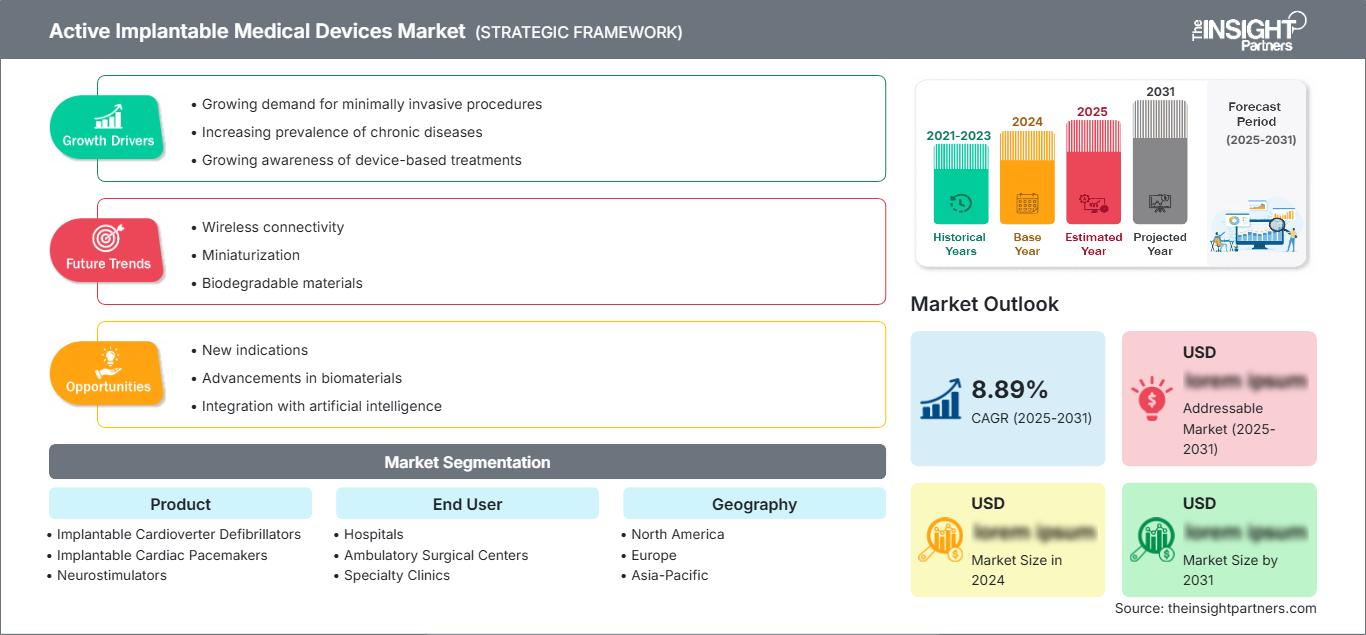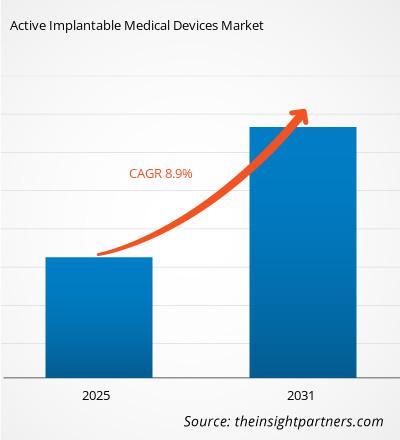Le marché des dispositifs médicaux implantables actifs devrait enregistrer un TCAC de 8,89 % entre 2025 et 2031, avec une taille de marché passant de XX millions de dollars américains en 2024 à XX millions de dollars américains d'ici 2031.
Le rapport est segmenté par produit [défibrillateurs cardioverteurs implantables (défibrillateurs cardioverteurs implantables transveineux et défibrillateurs cardioverteurs implantables sous-cutanés), stimulateurs cardiaques implantables, neurostimulateurs, appareils auditifs implantables, dispositifs d'assistance ventriculaire et moniteurs cardiaques implantables/enregistreurs de boucle insérables] et utilisateur final (hôpitaux, centres de chirurgie ambulatoire et cliniques spécialisées). L'analyse mondiale est ensuite ventilée au niveau régional et par principaux pays. Français Le rapport offre la valeur en USD pour l'analyse et les segments ci-dessus.
Objectif du rapport
Le rapport Marché actif des dispositifs médicaux implantables de The Insight Partners vise à décrire le paysage actuel et la croissance future, les principaux facteurs moteurs, les défis et les opportunités. Cela fournira des informations à diverses parties prenantes commerciales, telles que :
- Fournisseurs/fabricants de technologies : pour comprendre l'évolution de la dynamique du marché et connaître les opportunités de croissance potentielles, leur permettant de prendre des décisions stratégiques éclairées.
- Investisseurs : pour réaliser une analyse complète des tendances concernant le taux de croissance du marché, les projections financières du marché et les opportunités qui existent tout au long de la chaîne de valeur.
- Organismes de réglementation : pour réglementer les politiques et les activités de police sur le marché afin de minimiser les abus, de préserver la confiance des investisseurs et de maintenir l'intégrité et la stabilité du marché.
Segmentation du marché des dispositifs médicaux implantables actifs Produit
- Défibrillateurs automatiques implantables
- Stimulateurs cardiaques implantables
- Neurostimulateurs
- Appareils auditifs implantables
- Dispositifs d'assistance ventriculaire
- Moniteurs cardiaques implantables/Enregistreurs de boucle insérables
Utilisateur final
- Hôpitaux
- Centres de chirurgie ambulatoire
- Cliniques spécialisées
Vous bénéficierez d’une personnalisation sur n’importe quel rapport - gratuitement - y compris des parties de ce rapport, ou une analyse au niveau du pays, un pack de données Excel, ainsi que de profiter d’offres exceptionnelles et de réductions pour les start-ups et les universités
Marché des dispositifs médicaux implantables actifs: Perspectives stratégiques

- Obtenez les principales tendances clés du marché de ce rapport.Cet échantillon GRATUIT comprendra une analyse de données, allant des tendances du marché aux estimations et prévisions.
Facteurs de croissance du marché des dispositifs médicaux implantables actifs
- Demande croissante de procédures mini-invasives : les dispositifs implantables actifs tels que les stimulateurs cardiaques, les défibrillateurs cardioverteurs implantables (DCI) et les neurostimulateurs sont conçus pour offrir des options de traitement mini-invasives aux patients.
- Prévalence croissante des maladies chroniques : l’incidence croissante de maladies chroniques telles que le diabète, l’hypertension et les troubles neurologiques stimule la demande de dispositifs implantables actifs.
- Sensibilisation croissante aux traitements par dispositifs : les prestataires de soins de santé et les patients reconnaissent de plus en plus les avantages des traitements par dispositifs, qui sont souvent plus efficaces et plus rentables que les thérapies pharmaceutiques traditionnelles.
Tendances futures du marché des dispositifs médicaux implantables actifs
- Connectivité sans fil : la tendance à la connectivité sans fil permet la surveillance et le contrôle à distance des dispositifs implantables actifs, améliorant ainsi les résultats pour les patients et réduisant les coûts des soins de santé.
- Miniaturisation : Le développement de dispositifs plus petits et plus compacts permet une implantation sur plusieurs sites, améliorant le confort du patient et réduisant les risques chirurgicaux.
- Matériaux biodégradables : L'utilisation de matériaux biodégradables réduit le risque de complications liées aux dispositifs et permet le développement d'implants plus complexes.
Opportunités de marché des dispositifs médicaux implantables actifs
- Nouvelles indications : La découverte de nouvelles indications thérapeutiques pour les dispositifs implantables actifs devrait stimuler la croissance du marché.
- Progrès dans les biomatériaux : Le développement de nouveaux biomatériaux présentant une biocompatibilité, une durabilité et une fonctionnalité améliorées devrait permettre la création de dispositifs implantables actifs plus sophistiqués.
- Intégration à l'intelligence artificielle : L'intégration de l'intelligence artificielle (IA) aux dispositifs implantables actifs devrait améliorer la précision du diagnostic, les résultats du traitement et l'engagement des patients.
Aperçu régional du marché des dispositifs médicaux implantables actifs
Les tendances régionales et les facteurs influençant le marché des dispositifs médicaux implantables actifs tout au long de la période de prévision ont été analysés en détail par les analystes de The Insight Partners. Cette section aborde également les segments et la géographie du marché des dispositifs médicaux implantables actifs en Amérique du Nord, en Europe, en Asie-Pacifique, au Moyen-Orient et en Afrique, ainsi qu'en Amérique du Sud et en Amérique centrale.
Portée du rapport sur le marché des dispositifs médicaux implantables actifs
| Attribut de rapport | Détails |
|---|---|
| Taille du marché en 2024 | US$ XX million |
| Taille du marché par 2031 | US$ XX Million |
| TCAC mondial (2025 - 2031) | 8.89% |
| Données historiques | 2021-2023 |
| Période de prévision | 2025-2031 |
| Segments couverts |
By Produits
|
| Régions et pays couverts | Amérique du Nord
|
| Leaders du marché et profils d'entreprises clés |
|
Densité des acteurs du marché des dispositifs médicaux implantables actifs : comprendre son impact sur la dynamique commerciale
Le marché des dispositifs médicaux implantables actifs connaît une croissance rapide, portée par une demande croissante des utilisateurs finaux, due à des facteurs tels que l'évolution des préférences des consommateurs, les avancées technologiques et une meilleure connaissance des avantages du produit. Face à cette demande croissante, les entreprises élargissent leur offre, innovent pour répondre aux besoins des consommateurs et capitalisent sur les nouvelles tendances, ce qui alimente la croissance du marché.

- Obtenez le Marché des dispositifs médicaux implantables actifs Aperçu des principaux acteurs clés
- Analyse historique (2 ans), année de base, prévision (7 ans) avec TCAC
- Analyse PEST et SWOT
- Taille du marché Valeur / Volume - Mondial, Régional, Pays
- Industrie et paysage concurrentiel
- Ensemble de données Excel
Rapports récents
Rapports connexes
Témoignages
Raison d'acheter
- Prise de décision éclairée
- Compréhension de la dynamique du marché
- Analyse concurrentielle
- Connaissances clients
- Prévisions de marché
- Atténuation des risques
- Planification stratégique
- Justification des investissements
- Identification des marchés émergents
- Amélioration des stratégies marketing
- Amélioration de l'efficacité opérationnelle
- Alignement sur les tendances réglementaires




















 Obtenez un échantillon gratuit pour - Marché des dispositifs médicaux implantables actifs
Obtenez un échantillon gratuit pour - Marché des dispositifs médicaux implantables actifs